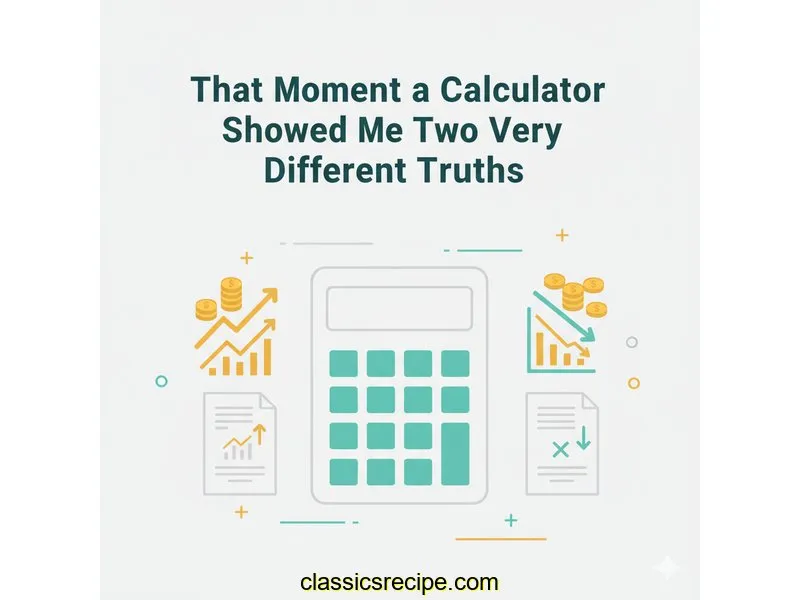
Auto Loan Calculator
Calculate payments over the life of your Loan
Home Blog Privacy Terms About Contact
Calculate payments over the life of your Loan
Home Blog Privacy Terms About ContactPublished on October 15, 2025

It all started with a simple conversation. My friend and I were chatting about some home improvement projects we were planning, and the topic of financing came up. He mentioned the personal loan he was considering, proudly stating his monthly payment would be just around $237. I was looking at a similar project, for a nearly identical amount, and the preliminary numbers I'd seen were closer to $332 per month. My immediate reaction was a mix of confusion and a little bit of envy. How was his payment almost $100 lower than mine?
We had similar credit profiles and were looking at borrowing the same amount, roughly $13,800. The interest rates we were discussing were also in the same ballpark, around 7.2%. My mind raced with questions. Did he find some secret lender? Was my understanding of these calculations completely off? It felt like I was missing a key piece of a puzzle that he had already solved. This wasn't about getting a loan; for me, it became a personal quest to understand the math. Why did two nearly identical scenarios produce such different monthly figures?
I decided to dive into online loan calculators, tools I had used before but perhaps never truly understood. My goal wasn't to find a cheaper loan but to grasp the mechanics behind the numbers. I wanted to see the gears turn and understand the relationship between the loan amount, the interest rate, the term, and that final monthly payment. It was time to move past just plugging in numbers and actually learn what the results were telling me.
This article is the story of that learning journey. It's about how I went from being confused by a simple comparison to finally understanding the deeper story the numbers were trying to tell me. Please remember, this is about understanding how calculations work, not financial advice. My aim is to share my process of discovery in the hopes it might help someone else feel more confident with these tools.
Armed with my newfound determination, I opened a loan calculator online. My first instinct was to replicate the two scenarios: my friend's and my own. I carefully entered the loan amount, $13,800, and the interest rate, 7.2%. My focus was almost entirely on the "Monthly Payment" output field. It felt like the only number that mattered because it's the one you feel in your budget each month.
I first put in a 72-month term, which I later learned was what my friend was considering. The calculator produced a monthly payment of $236.74. I rounded it to $237 in my head—exactly what he had mentioned. A small victory! Then, I changed the term to 48 months, which was the timeframe I had been thinking about. The result popped up: $332.18. Again, it matched my initial estimate.
For a moment, I just stared at the screen. The math was correct, but my understanding was still incomplete. My brain was stuck in a simple loop: "$237 is less than $332, therefore the $237 option is better." I was so fixated on that single data point that I completely ignored the other information on the page. Fields like "Total Principal Paid," "Total Interest Paid," and "Total of Payments" were just numbers on a screen, seemingly less important than the monthly figure.
My core mistake was thinking that the monthly payment was the final word on the matter. I was comparing two numbers without considering their context. I ran the calculations a few more times, tweaking the interest rate by a tenth of a percent, but the outcome remained the same. The longer-term loan always had the smaller monthly payment. I felt a growing sense of frustration, not with the calculator, but with myself. I knew there was a deeper truth hidden in the results, but I was looking at it from the wrong angle.
The turning point came when I stopped trying to prove one option was "cheaper" and started asking a different question: "Where does the money actually go?" I decided to ignore the monthly payment for a moment and focus on the other output fields. I reset the calculator with the initial data: $13,800 loan at 7.2% interest.
First, I selected the 72-month term. The monthly payment was $236.74. But this time, my eyes scanned down the page. I saw a field labeled "Total Interest Paid" and the number next to it was $3,264.88. Then I saw "Total of Payments," which read $17,064.88. Suddenly, a lightbulb went on. To borrow $13,800, the total amount repaid would be over $17,000.
With a sense of excitement, I changed the term to 48 months. The monthly payment jumped to $332.18, the number that had initially seemed so much higher. But then I looked at the other fields. The "Total Interest Paid" was now $2,136.44. The "Total of Payments" was $15,936.44. I had to read it twice. The option with the higher monthly payment involved paying over $1,100 less in total interest.
This was it. This was the piece of the puzzle I had been missing. The monthly payment and the total expense of the loan were telling two completely different, almost opposite, stories. One was about short-term cash flow, and the other was about long-term financial reality. I finally understood that I hadn't been comparing apples to apples; I had been comparing the price of a single apple slice to the price of the whole apple pie.
My entire perspective on loan calculations shifted. I realized the calculator wasn't just a simple tool for finding a monthly payment; it was an interactive dashboard for understanding financial trade-offs. Extending the loan term "buys" you a lower monthly payment, but the "price" you pay for that convenience is substantially more interest over time.
Many calculators also offered an "amortization schedule." Clicking on it was another revelation. For the 72-month loan, I could see that in the first year, a large portion of my $237 payment was going toward interest. For the 48-month loan, a greater percentage of each payment went toward the principal amount right from the start. This visual breakdown made it crystal clear why the longer loan was more expensive: you spend much more time paying off interest before making significant progress on the original loan balance.
To be sure I had it right, I ran a third scenario. What about a 36-month (3-year) term for the same $13,800 at 7.2%? The calculator showed a monthly payment of $428.14, which sounds high. But the total interest paid plummeted to just $1,604.86. The pattern was undeniable. A shorter term meant a higher monthly payment but a drastically lower total expense. I finally felt confident that I understood the dynamic relationship between these numbers.
This whole experience was incredibly empowering. It wasn't about making a financial choice, but about gaining the literacy to understand how those choices are structured. Here are the main lessons about the mechanics of calculations that I took away from this journey:
A lower monthly payment is usually achieved by extending the loan term (e.g., paying over 72 months instead of 48). While each payment is smaller, you make many more of them. This gives the loan balance more time to accrue interest, leading to a significantly higher amount of total interest paid over the life of the loan.
While the "Monthly Payment" is important for budgeting, for comparing the true expense of different loan structures, the "Total Interest Paid" and "Total of Payments" fields are arguably more critical. They provide a complete picture of the long-term financial commitment beyond the monthly cash flow.
An amortization schedule shows this clearly. In the early stages of a longer-term loan, a larger portion of your payment goes to interest. As the balance slowly decreases, more of the payment shifts toward the principal. With a shorter-term loan, this shift happens much more quickly, meaning you pay down the actual loan amount faster.
The calculation is straightforward once you have the monthly payment figured out. You simply multiply the monthly payment amount by the total number of payments (the loan term in months). For example, a $332 payment for 48 months equals $332 x 48 = $15,936 as the total amount you will pay back.

My biggest takeaway from this deep dive wasn't about which loan term is "better"—that's a personal decision based on individual circumstances. My real discovery was the importance of looking beyond the headline number. The "Monthly Payment" is designed to be simple and easy to digest, but the real story is often in the details that calculators provide, like total interest and total payments.
I started this journey confused about a simple number, and I ended it with a much richer understanding of how these financial mechanics work. Learning to ask "What's the total expense?" instead of just "What's the monthly payment?" has given me a new sense of confidence. It’s a reminder that taking a moment to explore the numbers and understand their relationships can demystify complex topics.
I encourage anyone who feels intimidated by these calculations to spend some time with an online calculator. Change the variables, watch how the outputs react, and read every field. It's not about becoming a math expert; it's about becoming literate in the language of these common financial tools.
This article is about understanding calculations and using tools. For financial decisions, always consult a qualified financial professional.
Disclaimer: This article documents my personal journey learning about loan calculations and how to use financial calculators. This is educational content about understanding math and using tools—not financial advice. Actual loan terms, rates, and costs vary based on individual circumstances, creditworthiness, and lender policies. Calculator results are estimates for educational purposes. Always verify calculations with your lender and consult a qualified financial advisor before making any financial decisions.
